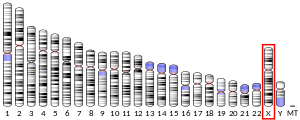SRPX2
Sushi repeat-containing protein SRPX2 is a protein that in humans is encoded by the SRPX2 gene, on the X chromosome.[5][6] It has roles in glutamatergic synapse formation in the cerebral cortex and is more highly expressed in childhood.[7] Bioinformatics analysis suggests the SRPX2 protein is a peroxiredoxin.[8]
Function
SRPX2 is distributed on synapses throughout the cerebral cortex and hippocampus, largely in the same areas as vesicular glutamate transporter 1 and DLG4. It is involved in synapse formation and is more highly expressed in childhood. Overexpression of SRPX2 results in increased density of vesicular glutamate transporter 1 and DLG4 clusters on cortical neurons. Deficiency results in decreased dendritic spine density of excitatory glutamatergic synapses, while inhibitory GABAergic synapses are unaffected. Length or shape of spines is not affected by SPRX2, however.[7]
Clinical significance
Mutations in SRPX2 were linked in one 2006 study to a family with a form of Rolandic epilepsy with intellectual disability and speech dyspraxia, however later studies showed that mutations in SRPX2 do not necessarily lead to epilepsy or intellectual disability. Additionally, no mutations in SRPX2 have been reported with Rolandic epilepsy since.[9] In mice, mutations in SRPX2 lead to decreased frequency of ultrasonic vocalisations in pups when separated from mothers.[7]
Interactions
FOXP2 directly reduces SRPX2 expression, by binding to its promoter. However, FOXP2 also reduces dendritic length, which SRPX2 does not affect, indicating it has other regulatory roles in dendritic morphology.[7]
References
- GRCh38: Ensembl release 89: ENSG00000102359 - Ensembl, May 2017
- GRCm38: Ensembl release 89: ENSMUSG00000031253 - Ensembl, May 2017
- "Human PubMed Reference:". National Center for Biotechnology Information, U.S. National Library of Medicine.
- "Mouse PubMed Reference:". National Center for Biotechnology Information, U.S. National Library of Medicine.
- Kurosawa H, Goi K, Inukai T, Inaba T, Chang KS, Shinjyo T, Rakestraw KM, Naeve CW, Look AT (January 1999). "Two candidate downstream target genes for E2A-HLF". Blood. 93 (1): 321–32. PMID 9864177.
- "Entrez Gene: SRPX2 sushi-repeat-containing protein, X-linked 2".
- Sia GM, Clem RL, Huganir RL (November 2013). "The human language-associated gene SRPX2 regulates synapse formation and vocalization in mice". Science. 342 (6161): 987–91. Bibcode:2013Sci...342..987S. doi:10.1126/science.1245079. PMC 3903157. PMID 24179158.
- Pawłowski K, Muszewska A, Lenart A, Szczepińska T, Godzik A, Grynberg M (2010). "A widespread peroxiredoxin-like domain present in tumor suppression- and progression-implicated proteins". BMC Genomics. 11: 590. doi:10.1186/1471-2164-11-590. PMC 3091736. PMID 20964819.
- "OMIM Entry - # 300643 - ROLANDIC EPILEPSY, MENTAL RETARDATION, AND SPEECH DYSPRAXIA, X-LINKED; RESDX". omim.org. Retrieved 2020-01-17.
Further reading
- Suzuki Y, Taira H, Tsunoda T, Mizushima-Sugano J, Sese J, Hata H, Ota T, Isogai T, Tanaka T, Morishita S, Okubo K, Sakaki Y, Nakamura Y, Suyama A, Sugano S (May 2001). "Diverse transcriptional initiation revealed by fine, large-scale mapping of mRNA start sites". EMBO Reports. 2 (5): 388–93. doi:10.1093/embo-reports/kve085. PMC 1083880. PMID 11375929.
- Suzuki Y, Yamashita R, Shirota M, Sakakibara Y, Chiba J, Mizushima-Sugano J, Nakai K, Sugano S (September 2004). "Sequence comparison of human and mouse genes reveals a homologous block structure in the promoter regions". Genome Research. 14 (9): 1711–8. doi:10.1101/gr.2435604. PMC 515316. PMID 15342556.
- Otsuki T, Ota T, Nishikawa T, Hayashi K, Suzuki Y, Yamamoto J, Wakamatsu A, Kimura K, Sakamoto K, Hatano N, Kawai Y, Ishii S, Saito K, Kojima S, Sugiyama T, Ono T, Okano K, Yoshikawa Y, Aotsuka S, Sasaki N, Hattori A, Okumura K, Nagai K, Sugano S, Isogai T (2007). "Signal sequence and keyword trap in silico for selection of full-length human cDNAs encoding secretion or membrane proteins from oligo-capped cDNA libraries". DNA Research. 12 (2): 117–26. doi:10.1093/dnares/12.2.117. PMID 16303743.
- Kimura K, Wakamatsu A, Suzuki Y, Ota T, Nishikawa T, Yamashita R, Yamamoto J, Sekine M, Tsuritani K, Wakaguri H, Ishii S, Sugiyama T, Saito K, Isono Y, Irie R, Kushida N, Yoneyama T, Otsuka R, Kanda K, Yokoi T, Kondo H, Wagatsuma M, Murakawa K, Ishida S, Ishibashi T, Takahashi-Fujii A, Tanase T, Nagai K, Kikuchi H, Nakai K, Isogai T, Sugano S (January 2006). "Diversification of transcriptional modulation: large-scale identification and characterization of putative alternative promoters of human genes". Genome Research. 16 (1): 55–65. doi:10.1101/gr.4039406. PMC 1356129. PMID 16344560.
- Roll P, Rudolf G, Pereira S, Royer B, Scheffer IE, Massacrier A, Valenti MP, Roeckel-Trevisiol N, Jamali S, Beclin C, Seegmuller C, Metz-Lutz MN, Lemainque A, Delepine M, Caloustian C, de Saint Martin A, Bruneau N, Depétris D, Mattéi MG, Flori E, Robaglia-Schlupp A, Lévy N, Neubauer BA, Ravid R, Marescaux C, Berkovic SF, Hirsch E, Lathrop M, Cau P, Szepetowski P (April 2006). "SRPX2 mutations in disorders of language cortex and cognition". Human Molecular Genetics. 15 (7): 1195–207. doi:10.1093/hmg/ddl035. PMID 16497722.
- Royer B, Soares DC, Barlow PN, Bontrop RE, Roll P, Robaglia-Schlupp A, Blancher A, Levasseur A, Cau P, Pontarotti P, Szepetowski P (2008). "Molecular evolution of the human SRPX2 gene that causes brain disorders of the Rolandic and Sylvian speech areas". BMC Genetics. 8: 72. doi:10.1186/1471-2156-8-72. PMC 2151080. PMID 17942002.




